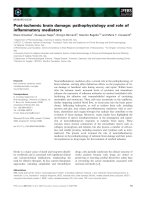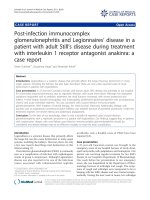Post tooth extraction necrotising fasciitis and rhinocerebral mucormycosis in a diabetic patient
Bạn đang xem bản rút gọn của tài liệu. Xem và tải ngay bản đầy đủ của tài liệu tại đây (351.21 KB, 5 trang )
Int.J.Curr.Microbiol.App.Sci (2018) 7(7): 2408-2412
International Journal of Current Microbiology and Applied Sciences
ISSN: 2319-7706 Volume 7 Number 07 (2018)
Journal homepage:
Original Research Article
/>
Post Tooth Extraction Necrotising Fasciitis and Rhinocerebral
Mucormycosis in a Diabetic Patient
Ekta Gupta1, Usha Verma2*, Prameshwar Lal3, P.C. Gupta4 and Prabhu Prakash2
1
2
Department of Orthodonics, Vyas Dental College, Jodhpur, India
Department of Microbiology, 3Department of Surgery, Dr. S.N.Medical, College,
Jodhpur, India
4
Department of Surgery, Paota Hosp. Asso. Group of Hosp.,
Dr S.N.Medical College Jodhpur, India
*Corresponding author
ABSTRACT
Keywords
Mucormycosis,
DM-1, ICU,
Cerebralmucormyc
osis, Maxillary
sinusitis,
Necrotising
fasciitis.
Article Info
Accepted:
17 June 2018
Available Online:
10 July 2018
Dentists and oral surgeons perform tooth extractions. If the tooth is impacted, they cut
away gum and bone tissue which cover the tooth and then, using forceps, grasp the
tooth and gently rock it back and forth to loosen it from the jaw bone and ligaments
that hold it in place. Once the tooth has been extracted, a blood clot usually forms in
the socket. Sometimes, the blood clot in the socket breaks loose, exposing the socket
leading to dry socket. But when this wok of tooth extraction is performed by
unauthorized and unskilled persons there is breach in protocols. If patient is
immunocompromised there is risk of developing opportunistic infections may be
bacterial, fungal etc. Mucormycosis is an aggressive, frequently fatal invasive fungal
infection that can develop in patients with a number of predisposing conditions. We
report on a 18-year-old male patient with DM who developed an invasive fungal
disease of the facial bones, myositis, cerebritis after tooth extraction with uncontrolled
blood sugar from some quack 10 days back and was admitted with complains of
tender swelling over right cheek extending up to infraorbital region along with high
grade fever and altered sensorium. Patient died in ICU due to Mucormycosis.
Mucormycosis is an opportunistic fungal pathogen that has the ability to cause
significant morbidity and frequently mortality in the susceptible patient. An overview
of this class of pathogens and the history, examination findings (clinical and
radiographic), pathogenesis and medical–surgical treatment of mucormycosis is
presented.
Introduction
Cerebral mycosis is caused by a group of
fungi
including,
saprophytic
fungi,
Zygomycetes group of fungi, dimorphic fungi,
yeast and yeasts-like fungi. Zygomycosis is an
opportunistic fungal infection caused by class
Zygomycetes such as the Genera Rhizopus,
Rhizomucor, Absidia, Mucor etc. and may
present clinically as cutaneous, subcutaneous,
2408
Int.J.Curr.Microbiol.App.Sci (2018) 7(7): 2408-2412
systemic and rhinocerebral infections.
Cerebral mucormycosis is becoming more
frequently recognized as secondary occurrence
in diabetes mellitus patients. Zygomycetes
thrive in a highly acid condition that has rich
carbohydrate; therefore a diabetic ketoacidosis
person has a more risk of quick invasion. Burn
patients or patients receiving cancer
chemotherapy are also at risk (1-4).
renal failure, malignancies, intravenous drug
abuse, malnutrition states, as well as immunesuppression and corticosteroid therapy.
We are reporting a case of cerebral
mucormycosis after tooth extraction in a
young patient having uncontrolled blood sugar
(DM-1) by a road sidequack.
Case Report
Cases are commonly observed whenever there
is any breach in aseptic precautions;
commonly seen post brain surgeries or tooth
extraction.
Cerebral mucormycosis is becoming more
frequently recognized as secondary occurrence
in diabetes mellitus, burn or patients receiving
cancer chemotherapy. Zygomycetes thrive in a
highly acid condition that has rich
carbohydrate; therefore a diabetic ketoacidosis
person has a more risk of quick invasion.
Cases are commonly observed whenever there
is any breach in aseptic precautions;
commonly seen post brain surgeries or tooth.
Invasive fungal infections (mycoses) are
uncommon, but when they occur, they are
devastating to patients. These infections are
opportunistic - they occur when organisms to
which we are frequently exposed gain entry to
the body due to a decrease in host defenses or
through an invasive portal, such as a dental
extraction(5-8).
Mucormycosis is a saprophytic aerobic fungus
commonly found in our environment, for
example, in bread moulds or decaying
vegetation. This organism is frequently found
to colonize the oral mucosa, nasal mucosa,
paranasal sinuses and pharyngeal mucosa of
asymptomatic patients. These fungi do not
usually cause disease in healthy people with
intact immune systems, but patients with a
number of conditions can be predisposed to
the development of invasive fungal disease.
These conditions include diabetes mellitus,
18years, male, admitted with complains of
tender swelling over right cheek extending up
to infraorbital region along with high grade
fever, he gave history of tooth extraction by a
quack in a state of uncontrolled blood sugar
(pt. Was known case of DM-1 since last 2
years), 2 days after admission patient had
altered sensorium (Glasgow Coma Scale
(GCS) of patient was E3V4M5 and B.P. was
90/60 mmHg sugar >450 mg/dl, urinary
ketone bodies: 4+ and was hypokalaemia.
After 1 day of admission, patient became
unconscious with gasping respiration and so
was intubated and shifted on mechanical
ventilation. Meanwhile patient developed
necrosis of right half of face extending to
temporal region. Hypokalaemia persisted
throughout the hospital course and shortness
of breath and swelling extended up to right
side of whole face and converted into
necrotising fasciitis in spite of broad spectrum
antibiotic coverage .Patient was HIV, HBs Ag
negative, blood culture was negative, tissue
debribment over face was done and sent for
HPE & CULTURE. On HPE there was
presence of thick, broad fungal mycelium on
SDA culture it confirmed as case of
Mucormycosis. In spite of Fluconazole,
Voraconazole, Tygecycline, Vancomycin,
Metronidazole,
Mannitol
and
Dexona
infusions patient succumbed to death four
days after admission (Fig. 1–7).
MRI-Brain
cerebral
mucormycosis,
Maxillary sinusitis and necrotising fasciitis.
2409
Int.J.Curr.Microbiol.App.Sci (2018) 7(7): 2408-2412
Results and Discussion
Although permanent teeth can last a lifetime,
teeth that have become damaged or decayed
may need to be removed or extracted. Other
reasons include crowded mouth, Gum disease
or infection. Sometimes dentists extract teeth
to prepare the mouth for orthodontics. The
goal of orthodontics is to properly align the
teeth, which may not be possible if teeth are
too big for mouth. If tooth decay or damage
extends to the pulp -- the center of the tooth
containing nerves and blood vessels -- bacteria
in the mouth can enter the pulp, leading to
infection. If infection is so severe that
antibiotics do not cure it, extraction may be
needed to prevent the spread of infection. If
immune system is compromised (for example,
if patient is receiving chemotherapy or are
having an organ transplant) even the risk of
infection in a particular tooth may be reason to
remove the tooth. If periodontal disease -- an
infection of the tissues and bones that
surround and support the teeth -- have caused
loosening of the teeth, it may be necessary to
extract the tooth or teeth. Cerebral
mucormycosis is becoming more frequently
recognized as secondary occurrence in
diabetes mellitus, burn or patients receiving
cancer chemotherapy. Zygomycetes thrive in a
highly acid condition that has rich
carbohydrate; therefore a diabetic ketoacidosis
person has a more risk of quick invasion.
Cases are commonly observed whenever there
is any breach in aseptic precautions;
commonly seen post brain surgeries or tooth
Invasive fungal infections (mycoses) are
uncommon, but when they occur, they are
devastating to patients. These infections areo
pportunistic — they occur when organisms to
which we are frequently exposed gain entry to
the body due to a decrease in host defenses or
through an invasive portal, such as a dental
extraction.
Mucormycosis is a fungal infection due to
organisms in the order Mucorales. These
organisms belong to the general class
zygomycetes, which are ubiquitous. They can
be found in decaying vegetation, soil and
decaying food (for example bread mould).
These organisms can occasionally be cultured
from non-infected individuals. This organism
is frequently found to colonize the oral
mucosa, nasal mucosa, paranasal sinuses and
pharyngeal mucosa of asymptomatic patients.
These fungi do not usually cause disease in
healthy people with intact immune systems,
but patients with a number of conditions can
be predisposed to the development of invasive
fungal disease. These conditions include
diabetes mellitus, renal failure, malignancies,
intravenous drug abuse, malnutrition states, as
well
as
immunesuppression
and
corticosteroid therapy. Mucormycosis can
have multiple clinical presentations. The most
common is the rhinocerebral form, involving
the nose, paranasal sinuses, orbits and central
nervous system. Others include cutaneous,
gastroin-testinal, pulmonary and disseminated
forms. The rhinocerebral form has been sub
classified
into
rhino
maxillary
and
rhinocerebralorbital by some.
Rhinocerebral mucormycosis typically begins
with hyphal invasion of the paranasal sinuses
or the oronasal cavity of a susceptible host.
Early symptoms may include paranasal
paresthesias, cellulitis, periorbital edema,
rhinorrhea and nasal crusting. These features
are quickly superseded by eschar formation
and necrosis of the naso-facial region (6).
Advancing infection can quickly result in
cavernous sinus thrombosis, carotid artery or
jugular vein thrombosis (Lemierre Syndrome)
and death. Mucormycosis is an aggressive,
frequently fatal invasive fungal infection that
can develop in patients with a number of
predisposing conditions.
2410
Int.J.Curr.Microbiol.App.Sci (2018) 7(7): 2408-2412
Fig. 1,2- Dental I.O.P.A. of patient
Fig. 3,4- CT scan of patient showing cerebritis
Fig. 5,6- showing fascitis and ulcer present on face over maxillary sinus
Fig.7 Showing mucor grown on sabourad dextrose agar
2411
Int.J.Curr.Microbiol.App.Sci (2018) 7(7): 2408-2412
In the susceptible patient, it can be triggered by
minor surgical wounds, such as dental
extractions. Expeditious diagnosis, systemic
amphotericin B therapy, aggressive surgical
debridement and optimal medical management
are critical for patient survival. This case
reinforces the concept that simple procedures
such as dental extractions can cause
catastrophic complications in susceptible
patients. All dental professionals will encounter
patients whose general health is tenuous and
easily perturbed. Knowledge of potentially
devastating complications can help to prevent
the unfortunate consequences described here. In
this case, tooth extraction was done by a quack
in unsterilized condition with the associated
DM-1 with uncontrolled Blood sugar. Preoperative check-up was not done, intraoperative sterilization and post-operative care
was also compromised. Patient was ignorant
about the complications. Here poor hygiene and
uncontrolled blood sugar level of patient
played pivotal role in invasion of fungus.
Patient died due to invasion of fungus which
resulted in cutaneous necrotising fasciitis and
later on rhino cerebral mucormycosis. Despite
of all efforts patient succumbed to death.
Patient was diagnosed as a case of diabetic
ketoacidosis
with
rhinocerebral
and
subcutaneous mucormycosis which with time
progressed to septicaemia with septic shock
leading to respiratory failure. Patient was
managed under intensive care unit with life
support, vasopressor administration, i.v.
antibiotics, i.v. antifungals, insulin infusion and
potassium supplementation. But despite the
entire vigorous measures patient died.
2.
3.
4.
5.
6.
7.
8.
9.
10.
Grancini A. Invasive fungal infection in the
ICU: a multicentric, prospective, observational
study in Italy. Mycosis., 2011; 55:73-79.
Shmuel S, Stuart ML. The immune response to
fungal infections. Brit J Haemtol., 2005,
129:569-582.
Monnet G, Venet F, Kullberg BJ, Mihi GN.
ICU acquired immunosuppression and the risk
for secondary fungal infections. Med Mycol.,
2011:49:517-523.
Kofteridis DP, Karabekios S, Panagiotides JG,
Bizakis J, Kyrmizakis D, Saridaki Z:
Successful
treatment of rhinocerebral
mucormycosis with liposomal amphotericin B
and surgery in two diabetic patients with renal
dysfunction. J Chemother., 2003; 15(3):282–6.
Bhansali A, Bhadada S, Sharma A, Suresh V,
Gupta A, Singh P, and others. Presentation and
outcome
of
rhino-orbital-cerebral
mucormycosis in patients with diabetes.
Postgrad Med J 2004; 80(949):670–4..
Jones AC, Bentsen TY, Freedman PD.
Mucormycosis of the oral cavity. Oral Surg
Oral Med Oral Pathol., 1993; 75(4):455–60.
Talmi YP, Goldschmied-Reouven A, Bakon
M, Barshack I, Wolf M, Horowitz Z, and
others. Rhino-orbital and rhino-orbito-cerebral
mucormycosis. Otolaryngol Head Neck Surg.,
2002; 127(1):22–31.
Ferguson BJ. Mucormycosis of the nose and
Para nasal sinuses. Otolaryngol Clin North
Am., 2000; 33(2):349–65.
.Karam F, Chmel H. Rhino-orbital cerebral
mucormycosis. Ear Nose Throat J., 1990;
69(3):187, 191–3.
Garcia-Covarrubias L, Barratt DM, Bartlett R,
Van Meter K. [Treatment of mucormycosis
with adjunctive hyperbaric oxygen: five cases
treated at the same institution and review of the
literature]. Rev Invest Clin., 2004; 56(1):51–5
[Spanish].
References
1. Toranto AM, Dho G, Pritano A, Breda G,
How to cite this article:
Ekta Gupta, Usha Verma, Prameshwar Lal, P.C.Gupta and Prabhu Prakash. 2018. Post Tooth Extraction
Necrotising
Fasciitis
and
Rhinocerebral
Mucormycosis
in
a
Diabetic
Patient
Int.J.Curr.Microbiol.App.Sci. 7(07): 2408-2412. doi: />
2412









